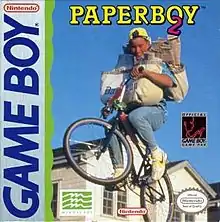Paperboy 2
Paperboy 2 is a sequel to the video game Paperboy. It was released in 1991–1992 for a large number of home systems.[1][2] While Paperboy debuted in arcades and was subsequently ported to home systems, this game was only released for consumer systems. It was released for the Amiga, Amstrad CPC, Atari ST, MS-DOS, Game Boy, Game Gear, Sega Mega Drive/Genesis, NES, SNES, and ZX Spectrum.
| Paperboy 2 | |
|---|---|
 Cover art for Game Boy version | |
| Developer(s) | Tengen Eastridge Technology (Amiga, DOS, Game Boy, NES, SNES) Manley & Associates (Game Gear) |
| Publisher(s) | Mindscape |
| Composer(s) | Rich Shemaria (Amiga, DOS, Game Boy, NES, SNES) Robert Ridihalgh (Game Gear) |
| Platform(s) | Amiga, Amstrad CPC, Atari ST, MS-DOS, Game Boy, Game Gear, Genesis, NES, SNES, ZX Spectrum |
| Release | 1991 |
| Genre(s) | Action |
| Mode(s) | Single-player Two-player |
Gameplay
The game was much like the original: the player controls a paperboy (or papergirl) who must navigate a bizarre series of obstacles,[3] such as tires rolling down a driveway while a car is being repaired, or strange houses like a haunted house, while trying to deliver the morning paper to various customers on a street (though unlike its predecessor, papers had to be delivered to houses on both sides of the street). Like the original, the game is renowned for its difficulty.
There are four specific actions that can be taken somewhere in the middle of each stage that reward the player with a front-page photo on the newspaper afterwards. Such actions included breaking a window with a paper, where the next day's paper would read "Mysterious Vandalism Baffles Police", showing an angry policeman looking at broken windows. Others could be coming across a gas station being robbed and hitting the gunman with a paper behind his back, then having the next day's paper headlined with "Paperboy {Papergirl} Foils Armed Robbery" or seeing a runaway baby carriage and stopping it with a paper, and the forthcoming headline being "Girl {Boy} Saves Breakway Baby". Both heroic stories would show a happy policeman rewarding the paperboy with candy.
Reception
Three reviewers for Electronic Gaming Monthly gave the Game Boy version a 6 out of 10, while a fourth reviewer gave it a 5.[4] Ed Ricketts of Amiga Format gave the Amiga version a 44 percent rating.[5] N-Force gave the NES version a 42 percent rating.[6] Jonathan Gagnon of Game Players gave the Game Gear version a 5 out of 10.[7] Jonathan Davies of Super Play gave the SNES version a 29 percent rating.[8] Brett Alan Weiss of AllGame gave the SNES version one and a half stars out of five.[9] Total! gave the NES version 50 out of 100, criticizing its poor camera and controls, as well as the music and gameplay.[10] Sega Force reviewed the Mega Drive/Genesis version and rated it 55 out of 100. The magazine praised the music and sound effects, but criticized the repetitive gameplay, and stated that the game looked outdated compared to other games available at the time.[11]
References
- "Paperboy 2 for Amiga (1992) - MobyGames". MobyGames. Retrieved June 21, 2017.
- "Great Expectations for 1992". GamePro. February 1992. p. 44. Retrieved March 16, 2018.
- "Paperboy 2 (SNES)". Nintendo Power. December 1991. p. 86. Retrieved March 16, 2018.
- "Paperboy 2 (Game Boy)". Electronic Gaming Monthly. February 1992. p. 30. Retrieved March 16, 2018.
- Ricketts, Ed (October 1992). "Paperboy 2 (Amiga)". Amiga Format. p. 94. Retrieved March 16, 2018.
- "Paperboy 2 (NES)". N-Force. October 1992. pp. 62–63. Retrieved March 16, 2018.
- Gagnon, Jonathan (December 1993). "Paper Boy 2 (Game Gear)". Game Players. p. 194. Retrieved March 16, 2018.
- Davies, Jonathan (December 1992). "Paperboy 2 (SNES)". Super Play. p. 80. Retrieved March 16, 2018.
- Weiss, Brett Alan. "Paperboy 2 - Review (SNES)". AllGame. Archived from the original on November 15, 2014. Retrieved March 14, 2018.
- "Paperboy 2 (NES)". Total!. February 1993. p. 57. Retrieved April 17, 2018.
- "Paperboy II (Mega Drive)". Sega Force. United Kingdom. June 1993. pp. 40–42.